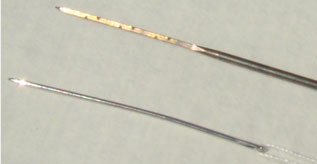 Loading... Please wait...
Loading... Please wait...Categories
Felting-FAQ
Any other questions? Please contact us at: info@birkelandwool.com.
What is needle felting?
 |
 |
 |
Also known as dry felting, needle felting is a technique of felting wool using specialized needles. Dry pieces of wool are felted together by jabbing the felting needles into the wool repeatedly. The needles can be hand held, used in multi-needle hand tools, or put into an embellishing machine (similar to a sewing machine). Felting needles have barbs which are designed for catching and compacting fibres; normal needles cannot be used for felting. Needle felting can be used to create wool 3D sculptures or to embellish fabric with designs in 2D.
Youtube often has good videos on how to needle felt if you do a search for it.
Click here to view our current class offerings for felting.
Click here to purchase felting needles and other equipment for felting.
Click here to purchase wool sliver for felting.
What is wet felting?
 An example of needle (the mouse) |
Wet felting is the technique of felting wool using soap, water, and agitation. There are many methods for wet felting. A common method is to:
- Lay out dry wool onto a bamboo mat (like bamboo blinds)
- Thoroughly wet the wool with hot, soapy water
- Roll the wool up in the mat and roll it back and forth, unrolling the mat and turning the felt periodically so it felts evenly
Youtube often has good videos on how to wet felt if you do a search for it.
Click here to view our current class offerings for felting.
Click here to purchase mats and other equipment for felting.
Click here to purchase wool sliver for felting.
Why does wool felt?
 |
The story of Felt: Legend has it that felt was discovered by a monk who, having lined his sandals with wool to keep his feet more comfortable, noticed that after he walked on the material for a while, and got it wet in rain and creek water, that the wool fibres bonded together to form a material which could be used for making different pieces of clothing or other items like bags and even hats.
Wool (and some other natural fibres, including human hair) has microscopic scales which allow the fibres to lock together, forming felt.
Some wool felts better than others:
- Polwarth and Merino felt up quickly
- Perendale, Corriedale, Coopworth, and Borderdale takes a little longer
- Southdown and Romney takes much longer to felt
